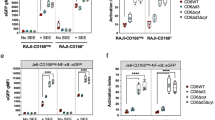Abstract
T cells are an immune cell lineage that play a central role in protection against pathogen infection. Antigen, in the form of pathogen-derived peptides, stimulates the T-cell receptor (TCR), leading to activation of the transcription factor, nuclear factor kappa B (NF-κB). The subsequent NF-κB-dependent gene expression program drives expansion and effector differentiation of antigen-specific T cells, leading to the adaptive anti-pathogen immune response. The cell surface TCR transmits activating signals to cytosolic NF-κB by a complex signaling cascade, in which the adapter protein Bcl10 plays a key role. We have previously demonstrated that TCR engagement leads to the formation of cytosolic Bcl10 clusters, called POLKADOTS, that provide a platform for the assembly of the terminal signaling complex that ultimately mediates NF-κB activation. In this chapter, we describe the methods utilized to visualize the formation of TCR-induced POLKADOTS and to study the temporal association between POLKADOTS formation and nuclear translocation of the NF-κB subunit, RelA/p65.
Access this chapter
Tax calculation will be finalised at checkout
Purchases are for personal use only
Similar content being viewed by others
References
Blum JS, Wearsch PA, Cresswell P (2013) Pathways of antigen processing. Annu Rev Immunol 31:443–473
Neefjes J, Jongsma ML, Paul P et al (2011) Towards a systems understanding of MHC class I and MHC class II antigen presentation. Nat Rev Immunol 11:823–836
Paul S, Schaefer BC (2013) A new look at T cell receptor signaling to nuclear factor-kappaB. Trends Immunol 34:269–281
Smith-Garvin JE, Koretzky GA, Jordan MS (2009) T cell activation. Annu Rev Immunol 27:591–619
Thome M, Charton JE, Pelzer C et al (2010) Antigen receptor signaling to NF-kappaB via CARMA1, BCL10, and MALT1. Cold Spring Harb Perspect Biol 2:a003004
Sun L, Deng L, Ea CK et al (2004) The TRAF6 ubiquitin ligase and TAK1 kinase mediate IKK activation by BCL10 and MALT1 in T lymphocytes. Mol Cell 14:289–301
Vallabhapurapu S, Karin M (2009) Regulation and function of NF-kappaB transcription factors in the immune system. Annu Rev Immunol 27:693–733
Dustin ML, Chakraborty AK, Shaw AS (2010) Understanding the structure and function of the immunological synapse. Cold Spring Harb Perspect Biol 2:a002311
Monks CR, Freiberg BA, Kupfer H et al (1998) Three-dimensional segregation of supramolecular activation clusters in T cells. Nature 395:82–86
Paul S, Kashyap AK, Jia W et al (2012) Selective autophagy of the adaptor protein Bcl10 modulates T cell receptor activation of NF-kappaB. Immunity 36:947–958
Rossman JS, Stoicheva NG, Langel FD et al (2006) POLKADOTS are foci of functional interactions in T-Cell receptor-mediated signaling to NF-kappaB. Mol Biol Cell 17:2166–2176
Schaefer BC, Kappler JW, Kupfer A et al (2004) Complex and dynamic redistribution of NF-kappaB signaling intermediates in response to T cell receptor stimulation. Proc Natl Acad Sci U S A 101:1004–1009
Paul SKA, Traver MK, Kashyap AK et al (2014) TCR signals to NF-κB are transmitted by cytosolic p62-Bcl10-Malt1 signalosome. Sci Signal 13:ra45
Haughton G, Arnold LW, Bishop GA et al (1986) The CH series of murine B cell lymphomas: neoplastic analogues of Ly-1+ normal B cells. Immunol Rev 93:35–51
Rebeaud F, Hailfinger S, Posevitz-Fejfar A et al (2008) The proteolytic activity of the paracaspase MALT1 is key in T cell activation. Nat Immunol 9:272–281
Schaefer BC, Mitchell TC, Kappler JW et al (2001) A novel family of retroviral vectors for the rapid production of complex stable cell lines. Anal Biochem 297:86–93
Jordan M, Schallhorn A, Wurm FM (1996) Transfecting mammalian cells: optimization of critical parameters affecting calcium-phosphate precipitate formation. Nucleic Acids Res 24:596–601
Naviaux RK, Costanzi E, Haas M et al (1996) The pCL vector system: rapid production of helper-free, high-titer, recombinant retroviruses. J Virol 70:5701–5705
Fitch FW, Gajewski TF, Hu-Li J (2006) Production of TH1 and TH2 cell lines and clones. Curr Protoc Immunol Chapter 3:Unit 3.13
Kaye J, Porcelli S, Tite J, Jones B, Janeway CA Jr (1983) Both a monoclonal antibody and antisera specific for determinants unique to individual cloned helper T cell lines can substitute for antigen and antigen-presenting cells in the activation of T cells. J Exp Med 158:836–856
Acknowledgments
Supported by grants from the US National Institutes of Health (Al057481 to B.C.S.), Center for Neuroscience and Regenerative Medicine (CNRM) (to B.C.S.), and predoctoral fellowships (to S.P.) from the American Heart Association (10PRE3150039) and the Henry M. Jackson Foundation. The views expressed are those of the authors and do not necessarily reflect those of the Uniformed Services University or the Department of Defense.
Author information
Authors and Affiliations
Corresponding author
Editor information
Editors and Affiliations
Rights and permissions
Copyright information
© 2015 Springer Science+Business Media New York
About this protocol
Cite this protocol
Paul, S., Schaefer, B.C. (2015). Visualizing TCR-Induced POLKADOTS Formation and NF-κB Activation in the D10 T-Cell Clone and Mouse Primary Effector T Cells. In: May, M. (eds) NF-kappa B. Methods in Molecular Biology, vol 1280. Humana Press, New York, NY. https://doi.org/10.1007/978-1-4939-2422-6_12
Download citation
DOI: https://doi.org/10.1007/978-1-4939-2422-6_12
Published:
Publisher Name: Humana Press, New York, NY
Print ISBN: 978-1-4939-2421-9
Online ISBN: 978-1-4939-2422-6
eBook Packages: Springer Protocols




